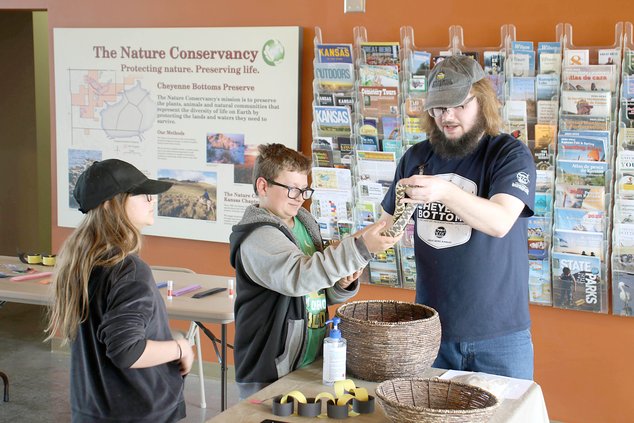For the Kansas Wetlands Education Center, the start to a busy spring season usually begins around spring break.
The KWEC wrapped up its latest spring break week Friday, offering young students a chance to meet Queenie, test their smelling smarts and craft a slithery friend.
Queenie is a speckled kingsnake, usually found on the open prairies of the Central Plains. Her docile disposition makes her an ideal subject to learn about snakes and their abilities, notes Alec Zaborniak, who developed Friday’s activity as one of four grad students studying at Fort Hays State University at Cheyenne Bottoms.
“I like snakes,” noted Zaborniak. “There are a lot of things you can learn from them. Not all snakes are scary,” he said. While at KWEC, the graduate students staff the front desk and help with animal care.
During the week of spring break, they are given a challenge to come up with an activity to present each day of the week.
On Monday, it was plants; Tuesday, formation of the Bottoms; Wednesday, birds and their beak adaptations; and Thursday, reptiles.
In his Friday presentation, Zaborniak said not all snakes are venomous, or aggressive. Speckled kingsnakes like Queenie can be found across three-fourths of the state, in open woodlands and prairies, but you have to really look for them, he said. They are basically harmless, preferring to hide under rocks, logs or old animal burrows.
On defense, they are good actors; when threatened, they may whip their tail to rustle a pile of leaves and strike, pretending to be a venomous rattlesnake. They mostly eat other snakes, including venomous ones, but also eat rodents, lizards, birds and their eggs, and turtle eggs.
The focus of Zaborniak’s presentation was how snakes utilize their sense of smell, using their forked tongue to activate an organ at the base of their skull, inside their mouth.
Young participants also were invited to take a “smelling quiz,” identifying several different flavors, and finish up by making a paper-chain snake to take home.
KWEC ramping up for spring
Mandy Kearn, KWEC’s programming specialist, noted that attendance numbers were moving up compared to the last couple of COVID-challenged years. “We’re kind of moving back on track,” she said.
The KWEC is moving into spring migration at Cheyenne Bottoms, expected to peak at the end of April or early May. “It’s really concentrated; the birds are in a hurry,” she said. “They want to get home, find their mate and get their nests built.”
KWEC’s youth-centered activities turn to the outdoors, with field trips available for school students, Kearn said. A variety of programs have been scheduled into the month of June.
The Kansas Wetlands Education Center is open Tuesday through Sunday, at 592 NE K-156, east of Great Bend.





